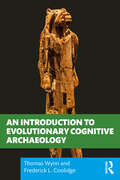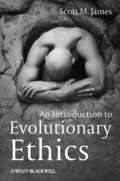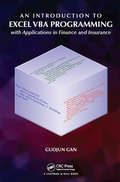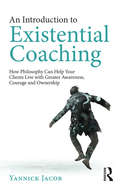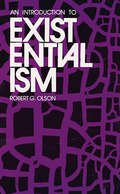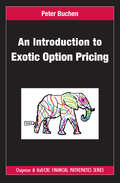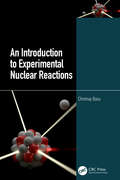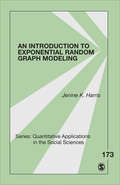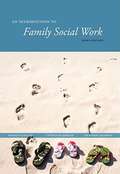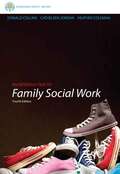- Table View
- List View
An Introduction to Evidence-based Practice in Nursing & Healthcare
by Alison PoolerThe beginner's guide to Evidence-based Practice for Nursing, Health and Social Care.An Introduction to Evidence-based Practice in Nursing & Health aims to help students, educators, mentors and professionals to make sense of knowledge derived from research and how to use it as a basis for making sound decisions about patient care. Covering everything from basic terminology to the application of Evidence-based Practice in your everyday routine, this text is the guide to better practice.Written in a accessible and interactive style, An Introduction to Evidence-based Practice in Nursing & Health clearly sets out what Evidence-based Practice is, why it is important and how you can use it successfully to improve patient care.Key Features for success in Evidence-based Practice:Simply and quickly shows you what Evidence-based Practice is and how you can use it. Helps you to develop an understanding of the policies driving Evidence-based Practice and professional development. Regular reinforcement of your learning through integrated Activities and end-of-chapter self assessment. Extensive references and suggestions for further reading and online research. Integrated Glossary keeps you up-to-date with the latest jargon.
An Introduction to Evolutionary Cognitive Archaeology
by Thomas Wynn Frederick L. CoolidgeAn Introduction to Evolutionary Cognitive Archaeology is the first concise introduction that lays out the epistemological foundations of evolutionary cognitive archaeology in a way that is accessible to students. The volume is divided into three sections. The first section situates cognitive archaeology in the pantheon of archaeological approaches and distinguishes between ideational cognitive archaeology and evolutionary cognitive archaeology. This is followed by a close look at the nature of cognitive archaeological inferences and concludes with brief summaries of the major methods of evolutionary cognitive archaeology. The second section of the book introduces the reader to a variety of cognitive phenomena that are accessible using the methods of cognitive archaeology: memory, technical cognition, spatial cognition, social cognition, art and aesthetics, and symbolism and language. The third section presents a brief outline of hominin cognitive evolution from the perspective of evolutionary cognitive archaeology. The authors divide the archaeological record into three major phases: The Bipedal Apes—3.3 million-1.7 million years ago; The Axe Age—1.7 million-300,000 years ago; and The Emergence of Modern Thinking—300,000–12,000 years ago. An Introduction to Evolutionary Cognitive Archaeology is an essential text for undergraduate students, graduate students, and scholars across the behavioral and social sciences interested in learning about cognitive archaeology, including psychologists, philosophers, anthropologists, and archaeologists.
An Introduction to Evolutionary Ethics
by Scott M. JamesOffering the first general introductory text to this subject, the timely Introduction to Evolutionary Ethics reflects the most up-to-date research and current issues being debated in both psychology and philosophy. The book presents students to the areas of cognitive psychology, normative ethics, and metaethics. The first general introduction to evolutionary ethics Provides a comprehensive survey of work in three distinct areas of research: cognitive psychology, normative ethics, and metaethics Presents the most up-to-date research available in both psychology and philosophy Written in an engaging and accessible style for undergraduates and the interested general reader Discusses the evolution of morality, broadening its relevance to those studying psychology
An Introduction to Excel VBA Programming: with Applications in Finance and Insurance
by Guojun GanExcel Visual Basic for Applications (VBA) can be used to automate operations in Excel and is one of the most frequently used software programs for manipulating data and building models in banks and insurance companies. An Introduction to Excel VBA Programming: with Applications in Finance and Insurance introduces readers to the basic fundamentals of VBA Programming while demonstrating applications of VBA to solve real-world problems in finance and insurance. Assuming no prior programming experience and with reproducible examples using code and data, this text is suitable for advanced undergraduate students, graduate students, actuaries, and financial analysts who wish to learn VBA. Features: Presents the theory behind the algorithms in detail Includes more than 100 exercises with selected solutions Provides VBA code in Excel files and data to reproduce the results in the book Offers a solutions manual for qualified instructors
An Introduction to Existential Coaching: How Philosophy Can Help Your Clients Live with Greater Awareness, Courage and Ownership
by Yannick JacobIn An Introduction to Existential Coaching Yannick Jacob provides an accessible and practical overview of existential thought and its value for coaches and clients. Jacob begins with an introduction to coaching as a powerful tool for change, growth, understanding and transformation before exploring existential philosophy and how it may be integrated into coaching practice. The book goes on to examine key themes in existentialism and how they show up in the coaching space, including practical models as well as their application to organisations and leadership. Jacob concludes by evaluating ethical dimensions of working existentially and offers guidance on how to establish an existential coaching practice, including how to gain clients and build relationships with strategic partners. With reflective questions, exercises, interventions and activities throughout, An Introduction to Existential Coaching will be invaluable for anyone wanting to live and work at greater depth or to succeed as an existential coach. Accessibly written and with a wide selection of references and resources, An Introduction to Existential Coaching is a vital guide for coaches in training as well as an inspiring addition to the repertoir of experienced practitioners. It serves academics and students to understand existential philosophy and allows professionals with coaching responsibilities to access more meaningful conversations.
An Introduction to Existentialism
by Robert G. OlsonIndispensable guide to one of the most influential thought systems of our century. Stressing the work of Heidegger and Sartre, it offers a careful and objective examination of the existentialist position and values -- freedom of choice, individual dignity, personal love, creative effort -- and answers to the eternal questions of the human condition.
An Introduction to Exotic Option Pricing (Chapman And Hall/crc Financial Mathematics Ser.)
by Peter BuchenIn an easy-to-understand, nontechnical yet mathematically elegant manner, An Introduction to Exotic Option Pricing shows how to price exotic options, including complex ones, without performing complicated integrations or formally solving partial differential equations (PDEs). The author incorporates much of his own unpublished work, including ideas
An Introduction to Experimental Nuclear Reactions
by Chinmay BasuAn Introduction to Experimental Nuclear Reactions is a book with a concise and simple approach to the subject of experimental nuclear physics. The subject being very technical, it is dealt with in a lucid way so that the reader can grasp the concept and later gain hands-on experience while doing fieldwork. In this book, theoretical, experimental and instrumentation aspects are covered with an emphasis on accelerator-based techniques, which form the basis for the subject of experimental nuclear physics. Other books on similar topics either concentrate on the physics aspects or are more focussed on the instrumentation and radiation detection techniques while accelerator-related concepts are less explained. One of the main standalone features of the book is its to-the-point approach so that the beginner is not lost in the never-ending details. This book discusses the following aspects: Basic introduction to nuclear reactions Two- and three-body kinematics Accelerator-based experimental techniques Basic aspects of the accelerator and accessories Vacuum physics Radiation detector physics and its associated electronics Theoretical modelling and errors This book is mainly intended for students who aspire to pursue a career in experimental nuclear physics research or work in a nuclear accelerator laboratory. Chinmay Basu, PhD, is a researcher in the field of experimental nuclear physics, and his present interests are in the field of low-energy nuclear astrophysics. He is a professor and head of an accelerator facility at the Saha Institute of Nuclear Physics, Kolkata, India.
An Introduction to Exponential Random Graph Modeling
by Jenine K. HarrisThis volume introduces the basic concepts of Exponential Random Graph Modeling (ERGM), gives examples of why it is used, and shows the reader how to conduct basic ERGM analyses in their own research. ERGM is a statistical approach to modeling social network structure that goes beyond the descriptive methods conventionally used in social network analysis. Although it was developed to handle the inherent non-independence of network data, the results of ERGM are interpreted in similar ways to logistic regression, making this a very useful method for examining social systems. Recent advances in statistical software have helped make ERGM accessible to social scientists, but a concise guide to using ERGM has been lacking. An Introduction to Exponential Random Graph Modeling, by Jenine K. Harris, fills that gap, by using examples from public health, and walking the reader through the process of ERGM model-building using R statistical software and the statnet package.
An Introduction to Fairbairn's Psychology of Dynamic Structure: The Analysis of Cultural Objects
by Graham S ClarkeAn Introduction to Fairbairn's Psychology of Dynamic Structure: The Analysis of Cultural Objects describes W. R. D. Fairbairn's model of endopsychic structure and includes his thoughts on the social and the aesthetic. It offers a modified version of Fairbairn's model based upon his thinking about the moral defence, psychic growth, and mature dependence. The model is brought to life by its application to the analysis of a number of cultural objects: Bronzino's An Allegory of Venus and Cupid, Dennis Potter's trailblazing miniseries The Singing Detective, the enchanting anime Spirited Away directed by Hayao Miyazaki, and the mind-bending cinematic experience that is Everything Everywhere All at Once. Author Graham S. Clarke also considers the current conditions affecting psychoanalysis and psychoanalytic theories: a society with increasing opposition to depth thinking of any sort and the rise of populism and the neoliberal notion of the 'self as entrepreneur'. He offers suggestions as to how these trends might be understood and challenged. In particular, he describes how Fairbairn's theory might be considered as, and provide a basis for, a critical realist personal relations approach to psychoanalysis. This book is ideal reading for all psychoanalysts and those interested in the cultural impact of the arts.
An Introduction to Family Social Work
by Catheleen Jordan Heather Coleman Don CollinsThis text is intended for Methods/Practice with Families (Mezzo) courses in Social Work as a basic primer that introduces students to an overview of practice with families. It can also be used in Generalist Practice courses in which instructors want to emphasize work with families. Likewise, it is appropriate for paraprofessional, two-year human services programs.
An Introduction to Family Social Work
by Donald Collins Catheleen Jordan Heather ColemanAN INTRODUCTION TO FAMILY SOCIAL WORK, Fourth Edition provides a strong foundation in the concepts and skills you will need to succeed in practice with families. The book offers engaging case studies, end-of-chapter exercises, illustrations, and graphics to familiarize you with the topics at hand.
An Introduction to Feminism
by Lorna FinlaysonAs well as providing a clear and critical introduction to the theory, this refreshing overview focuses on the practice of feminism with coverage of actions and activism, bringing the subject to life for newcomers as well as offering fresh perspectives for advanced students. Explanations of the main strands to feminism, such as liberalism, sit alongside an exploration of a range of approaches, such as radical, anarchist and Marxist feminism, and provide much-needed context against which more familiar historical themes may be understood. The author's broad and inclusive view conveys the diversity and disagreement within feminism with accessible clarity. The analysis of key terms equips readers with a critical understanding of the vocabulary of feminist debates that will be invaluable to undergraduate students.
An Introduction to Feminism and Theatre
by Elaine AstonAt last an accessible and intelligent introduction to the energising and challenging relationship between feminism and theatre. In this clear and enlightening book, Aston discusses wide-ranging theoretical topics and provides case studies including: * Feminism and theatre history * `M/Othering the self': French feminist theory and theatre * Black women: shaping feminist theatre * Performing gender: a materialist practice * Colonial landscapes Feminist thought is changing the way theatre is taught and practised. An Introduction to Feminism and Theatre is compulsory reading for anyone who requires a precise, insightful and up-to-date guide to this dynamic field of study.
An Introduction to Film Analysis: Technique and Meaning in Narrative Film
by Michael Ryan Melissa LenosAn Introduction to Film Analysis combines an introduction to filmmaking technique with rigorous and comprehensive training in film interpretation. Composed in an accessible style yet conversant with the latest, most advanced critical theories and methods, this innovative textbook can be reliably used on both the undergraduate and the graduate level. The book begins with chapters that familiarize students with the basic components of film technique. It connects technique to meaning and demonstrates, through numerous examples, how particular uses of film technique generate different meanings. Students will learn how films are made and how values are promoted, ideas communicated, and rhetorical arguments advanced through film technique. The second part of the book covers a range of interpretive methods, theories, and concerns. In each section, the author offers a sample reading of a film, followed by an "interpretive exercise" with suggestions for students to use in performing their own film interpretation. Carefully structured, beautifully written, and illustrated throughout, An Introduction to Film Analysis provides a thorough grounding in the subject for students around the world.
An Introduction to Film Genres (First Edition)
by Sarah Kozloff Stephen Prince David Desser Lester Friedman Martha NochimsonA brisk, accessible, and informative introduction to film genres. An Introduction to Film Genres, written by leading film scholars specifically for undergraduates who are new to the study of film, provides an introduction that helps students see thirteen film genres in a new light---to help them identify the themes, iconography, and distinctive stylistic traits of each genre. This purchase offers access to the digital ebook only
An Introduction to Film and TV Production: From Concept to Market
by Karen Russell Tameka Winston Joseph Richie Airielle J. TaylorThis streamlined, step-by-step guide provides students and newcomers in the field of media with an overview of the complete production process, from conceiving of an idea to marketing the final product. Readers will learn what it takes to create a concept, develop it, and then market and sell it. Chapters discuss pitching, producing, marketing visionary concepts, financing, and distributing content. Focused on traditional and non-traditional platforms including social media, websites, and online advertising, this book explores currently evolving media platforms, ideas, and practices and provides examples of how to navigate these unique creative processes. Interviews with business executives offer insider tips and tricks to creating a marketable project. In this book, you will learn how to: Distinguish between a "great idea" and a "marketable idea." Condense your concept into an effective "elevator pitch." Build a basic business plan. Create a marketing strategy, be it traditional, digital, or both. Establish a personal brand and portfolio that will grab the right attention. This book will be of great help to the student, independent filmmaker, and content creator looking to understand the process of getting their work produced, distributed, and marketed.
An Introduction to Financial Markets and Institutions
by Bruce Brown Maureen Burton Reynold F. NesibaCompletely revised and updated to include the ongoing financial crisis and the Obama administration's programs to combat it, this is the best available introductory textbook for an undergraduate course on Financial Markets and Institutions. It provides balanced coverage of theories, policies, and institutions in a conversational style that avoids complex models and mathematics, making it a student-friendly text with many unique teaching features. Financial crises, global competition, deregulation, technological innovation, and growing government oversight have significantly changed financial markets and institutions. The new edition of this text is designed to capture the ongoing changes, and to present an analytical framework that enables students to understand and anticipate changes in the financial system and accompanying changes in markets and institutions. The text includes Learning Objectives and end-of-chapter Key Words and Questions, and an online Instructor's Manual is available to adopters.
An Introduction to Financial Markets: A Quantitative Approach
by Paolo BrandimarteCOVERS THE FUNDAMENTAL TOPICS IN MATHEMATICS, STATISTICS, AND FINANCIAL MANAGEMENT THAT ARE REQUIRED FOR A THOROUGH STUDY OF FINANCIAL MARKETS This comprehensive yet accessible book introduces students to financial markets and delves into more advanced material at a steady pace while providing motivating examples, poignant remarks, counterexamples, ideological clashes, and intuitive traps throughout. Tempered by real-life cases and actual market structures, An Introduction to Financial Markets: A Quantitative Approach accentuates theory through quantitative modeling whenever and wherever necessary. It focuses on the lessons learned from timely subject matter such as the impact of the recent subprime mortgage storm, the collapse of LTCM, and the harsh criticism on risk management and innovative finance. The book also provides the necessary foundations in stochastic calculus and optimization, alongside financial modeling concepts that are illustrated with relevant and hands-on examples. An Introduction to Financial Markets: A Quantitative Approach starts with a complete overview of the subject matter. It then moves on to sections covering fixed income assets, equity portfolios, derivatives, and advanced optimization models. This book’s balanced and broad view of the state-of-the-art in financial decision-making helps provide readers with all the background and modeling tools needed to make “honest money” and, in the process, to become a sound professional. Stresses that gut feelings are not always sufficient and that “critical thinking” and real world applications are appropriate when dealing with complex social systems involving multiple players with conflicting incentives Features a related website that contains a solution manual for end-of-chapter problems Written in a modular style for tailored classroom use Bridges a gap for business and engineering students who are familiar with the problems involved, but are less familiar with the methodologies needed to make smart decisions An Introduction to Financial Markets: A Quantitative Approach offers a balance between the need to illustrate mathematics in action and the need to understand the real life context. It is an ideal text for a first course in financial markets or investments for business, economic, statistics, engineering, decision science, and management science students.
An Introduction to Financial Mathematics: Option Valuation (Chapman and Hall/CRC Financial Mathematics Series)
by Hugo D. JunghennIntroduction to Financial Mathematics: Option Valuation, Second Edition is a well-rounded primer to the mathematics and models used in the valuation of financial derivatives. The book consists of fifteen chapters, the first ten of which develop option valuation techniques in discrete time, the last five describing the theory in continuous time. The first half of the textbook develops basic finance and probability. The author then treats the binomial model as the primary example of discrete-time option valuation. The final part of the textbook examines the Black-Scholes model. The book is written to provide a straightforward account of the principles of option pricing and examines these principles in detail using standard discrete and stochastic calculus models. Additionally, the second edition has new exercises and examples, and includes many tables and graphs generated by over 30 MS Excel VBA modules available on the author’s webpage https://home.gwu.edu/~hdj/.
An Introduction to Financial Option Valuation
by Desmond J. HighamThis book is intended for use in a rigorous introductory PhD level course in econometrics, or in a field course in econometric theory. It covers the measure-theoretical foundation of probability theory, the multivariate normal distribution with its application to classical linear regression analysis, various laws of large numbers, central limit theorems and related results for independent random variables as well as for stationary time series, with applications to asymptotic inference of M-estimators, and maximum likelihood theory. Some chapters have their own appendices containing the more advanced topics and/or difficult proofs. Moreover, there are three appendices with material that is supposed to be known. Appendix I contains a comprehensive review of linear algebra, including all the proofs. Appendix II reviews a variety of mathematical topics and concepts that are used throughout the main text, and Appendix III reviews complex analysis. Therefore, this book is uniquely self-contained.
An Introduction to Finite Element Analysis Using Matlab Tools (Synthesis Lectures on Mechanical Engineering)
by Shuvra DasThis book is an attempt to develop a guide for the user who is interested in learning the method by doing. There is enough discussion of some of the basic theory so that the user can get a broad understanding of the process. And there are many examples with step-by-step instructions for the user to quickly develop some proficiency in using FEA. We have used Matlab and its PDE toolbox for the examples in this text. The syntax and the modeling process are easy to understand and a new user can become productive very quickly. The PDE toolbox, just like any other commercial software, can solve certain classes of problems well but is not capable of solving every type of problem. For example, it can solve linear problems but is not capable of handling non-linear problems. Being aware of the capabilities of any tool is an important lesson for the user and we have, with this book, tried to highlight that lesson as well.
An Introduction to Finite Projective Planes (Dover Books on Mathematics)
by Abraham Adrian Albert Reuben SandlerGeared toward both beginning and advanced undergraduate and graduate students, this self-contained treatment offers an elementary approach to finite projective planes. Following a review of the basics of projective geometry, the text examines finite planes, field planes, and coordinates in an arbitrary plane. Additional topics include central collineations and the little Desargues' property, the fundamental theorem, and examples of finite non-Desarguesian planes.Virtually no knowledge or sophistication on the part of the student is assumed, and every algebraic system that arises is defined and discussed as necessary. Many exercises appear throughout the book, offering significant tools for understanding the subject as well as developing the mathematical methods needed for its study. References and a helpful appendix on the Bruck-Ryser theorem conclude the text.
An Introduction to Finite Tight Frames
by Shayne F. WaldronThis textbook is an introduction to the theory and applications of finite tight frames, an area that has developed rapidly in the last decade. Stimulating much of this growth are the applications of finite frames to diverse fields such as signal processing, quantum information theory, multivariate orthogonal polynomials, and remote sensing. Featuring exercises and MATLAB examples in each chapter, the book is well suited as a textbook for a graduate course or seminar involving finite frames. The self-contained, user-friendly presentation also makes the work useful as a self-study resource or reference for graduate students, instructors, researchers, and practitioners in pure and applied mathematics, engineering, mathematical physics, and signal processing.

